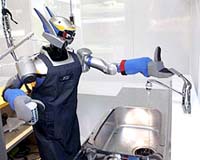 |
Canberra, Australia (SPX) Apr 23, 2010 A new report from CSIRO identifies five global megatrends and eight megashocks that are changing the world. "Megatrends are collections of interlinked trends that will change the way people live and the science and technology products that they demand," report co-author CSIRO's Dr James Moody says. "Megashocks are hard-to-predict risks defined by sudden and significant events, like the Asian tsunami and the GFC. "As well as informing science activities within CSIRO, we hope that this report will help inform Australian industry, government and community decisions. "Our aim is to take a fresh approach to understanding the future by using new data, methods, technology and ideas. "We welcome comment and input from experts and stakeholders to this work in progress." The megatrends presented in the report are based on analyses of over 100 trends contributed by leading scientists and business development staff across CSIRO. The report identifies megatrend one as 'more from less'. In a world of increasing demand for depleting natural resources, from minerals to water to fish, coming decades will see a focus on resource use efficiency and a major global effort on extracting more from less. The second megatrend is 'a personal touch'. Growth of the services sector, now representing over 70 per cent of the Australian economy, is being followed by a second wave of innovation aimed at tailoring and targeting services en masse, to individual customers. The third is 'divergent demographics', recognising the growing contrast between ageing OECD populations experiencing lifestyle and diet-related health problems, and high fertility rates and problems of not enough food for millions in poor countries. Megatrend four notes that more and more of the world's people are 'on the move', changing jobs, moving house and travelling more often and commuting further to work. The fifth megatrand is dubbed 'i World', predicting that everything in the natural world will have a digital counterpart. Report co-author Dr Stefan Hajkowicz says that the megashocks of our future world will have profound and far reaching implications for people's lives. "Our megashocks are based on 36 global risks identified by the World Economic Forum in 2009, from which we have identified eight risks particularly important from an Australian science and technology perspective. "These include oil and gas price spikes, pandemic influenza, biodiversity loss and extreme weather events related to climate change." Our Future World: An analysis of global trends, shocks and scenarios.
Share This Article With Planet Earth
Related Links CSIRO Space Tourism, Space Transport and Space Exploration News
 Japan eyes 'mind-reading' devices, robots by 2020: report
Japan eyes 'mind-reading' devices, robots by 2020: reportTokyo (AFP) April 22, 2010 Japan plans to develop "mind-reading" robots and consumer electronics that can be controlled by thought alone and hopes to market them within a decade, the Nikkei daily reported Thursday. The sci-fi like devices would employ so-called brain-machine interface technology, which analyses users' brain waves and brain blood-flow patterns detected through sensor-mounted headsets. The envisaged ... read more |
|
| The content herein, unless otherwise known to be public domain, are Copyright 1995-2010 - SpaceDaily. AFP and UPI Wire Stories are copyright Agence France-Presse and United Press International. ESA Portal Reports are copyright European Space Agency. All NASA sourced material is public domain. Additional copyrights may apply in whole or part to other bona fide parties. Advertising does not imply endorsement,agreement or approval of any opinions, statements or information provided by SpaceDaily on any Web page published or hosted by SpaceDaily. Privacy Statement |